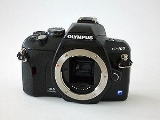
Olympus E-400
Encyclopedia
The Olympus E-400 is a digital single-lens reflex camera
launched by Olympus
on 14 September 2006, using the Four Thirds System
lens mount standard.. This 10 megapixel camera could be compared to other DSLRs unveiled during the summer of 2006 with comparable pixel count and price range: the Sony α 100, the Nikon D80
, the Canon EOS 400D
and the Pentax K10D
.
. It was accompanied by two new small zoom lenses, a 14–42 mm (28–84 mm 135 film format equivalent) f/3.5–5.6 standard zoom weighing 190g and a 40–150 mm (80–300 mm equivalent) f/4.0–5.6 long zoom weighing 220g. The body and single lens kit have a 700GB£ MSRP
and 850GB£ for the two lens kit.
The E-400, like all of the Olympus E-system cameras, uses Olympus' patented Supersonic Wave Filter
dust reduction system
to shake dust from the sensor during startup and when requested by the user; this largely eliminates the problem of dust accumulation on the surface of the image sensor.
The E-400 was controversial because Olympus only marketed it in Europe. The rest of the world had to wait for the E-410
, which did not arrive until the spring of 2007 and did not include the same Kodak sensor as the E-400. The E-410 replaced the Kodak sensor with the Panasonic sensor. Some claim the Kodak sensor produced smoother gradations and a higher quality image at lower ISO numbers.
Digital single-lens reflex camera
Most digital single-lens reflex cameras are digital cameras that use a mechanical mirror system and pentaprism to direct light from the lens to an optical viewfinder on the back of the camera....
launched by Olympus
Olympus Corporation
is a Japan-based manufacturer of optics and reprography products. Olympus was established on 12 October 1919, initially specializing in microscope and thermometer businesses. Its global headquarters are in Shinjuku, Tokyo, Japan, while its USA operations are based in Center Valley, Pennsylvania,...
on 14 September 2006, using the Four Thirds System
Four Thirds System
The Four Thirds system is a standard created by Olympus and Kodak for digital single-lens reflex camera design and development.The system provides a standard that, with digital cameras and lenses available from multiple manufacturers, allows for the interchange of lenses and bodies from different...
lens mount standard.. This 10 megapixel camera could be compared to other DSLRs unveiled during the summer of 2006 with comparable pixel count and price range: the Sony α 100, the Nikon D80
Nikon D80
The Nikon D80 is a digital single-lens reflex camera model announced by Nikon on August 9th, 2006. The camera shipped the first week of September to US retailers. Considered by many to be an amalgam of design elements of the entry-level D50 and high-end D200 cameras, it occupied the same price...
, the Canon EOS 400D
Canon EOS 400D
The EOS 400D, called Digital Rebel XTi in North America and EOS Kiss Digital X in Japan, is a mid-range digital single-lens reflex camera introduced by Canon August 24, 2006....
and the Pentax K10D
Pentax K10D
The Pentax K10D and similar Samsung GX-10 are 10.2 megapixel digital single-lens reflex cameras launched in late 2006. They were developed in a collaboration between Pentax of Japan and Samsung of Korea....
.
Features
The E-400 is notable for its small size, omitting the hand grip and exploiting the smaller sensor. It weighs only 375g and approaches manual focus film SLRs sizes, reminiscent of the Olympus OM systemOlympus OM system
The Olympus OM System was a line of 35mm single-lens reflex cameras, lenses and accessories sold by Olympus between 1972 and 2002 ....
. It was accompanied by two new small zoom lenses, a 14–42 mm (28–84 mm 135 film format equivalent) f/3.5–5.6 standard zoom weighing 190g and a 40–150 mm (80–300 mm equivalent) f/4.0–5.6 long zoom weighing 220g. The body and single lens kit have a 700GB£ MSRP
Suggested retail price
The manufacturer's suggested retail price , list price or recommended retail price of a product is the price which the manufacturer recommends that the retailer sell the product. The intention was to help to standardise prices among locations...
and 850GB£ for the two lens kit.
The E-400, like all of the Olympus E-system cameras, uses Olympus' patented Supersonic Wave Filter
Supersonic Wave Filter
The Supersonic Wave Filter is a dust reduction system developed by Olympus to overcome the negative effect of dust particles landing on the image sensor of digital SLRs. DSLRs are particularly vulnerable to this issue, since the interior of the camera is exposed during lens changes unlike other...
dust reduction system
Dust reduction system
A dust reduction system, or dust removal system, is a technology employed by several manufacturers of digital system cameras to solve the problem of dust particles adhering to the image sensor. Some systems remove or clean the sensor by vibrating at a very high frequency—between 100hertz and...
to shake dust from the sensor during startup and when requested by the user; this largely eliminates the problem of dust accumulation on the surface of the image sensor.
The E-400 was controversial because Olympus only marketed it in Europe. The rest of the world had to wait for the E-410
Olympus E-410
The Olympus E-410 is a 10 megapixel digital single-lens reflex camera intended be the smallest and lightest DSLR on the market...
, which did not arrive until the spring of 2007 and did not include the same Kodak sensor as the E-400. The E-410 replaced the Kodak sensor with the Panasonic sensor. Some claim the Kodak sensor produced smoother gradations and a higher quality image at lower ISO numbers.

